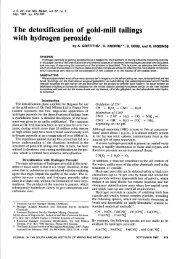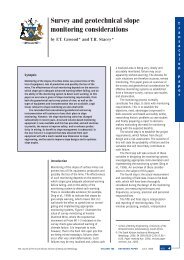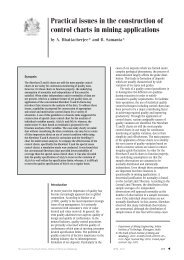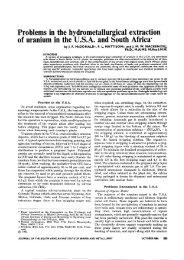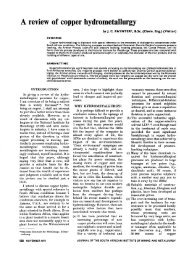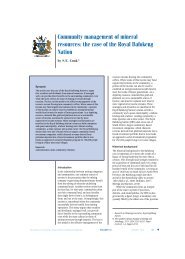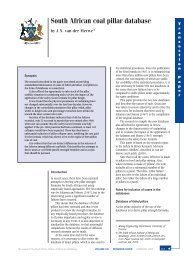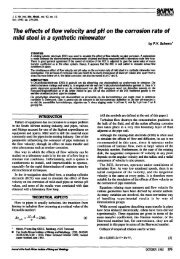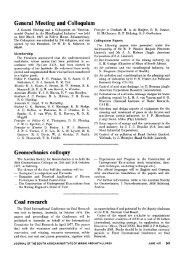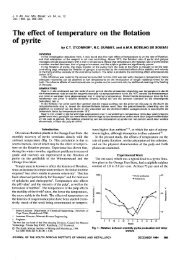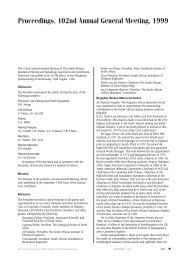The intensive cyanidation of gold-plant gravity concentrates - saimm
The intensive cyanidation of gold-plant gravity concentrates - saimm
The intensive cyanidation of gold-plant gravity concentrates - saimm
Create successful ePaper yourself
Turn your PDF publications into a flip-book with our unique Google optimized e-Paper software.
centrated solutions exceeding 1 gfl <strong>gold</strong>, 100 per cent<br />
current efficiency was obtained, but this efficiency decreased<br />
at lower concentrations and was about 40 per<br />
cent at 150 gft <strong>gold</strong>. <strong>The</strong> mild-steel wool was the type<br />
used for cleaning, and could be loaded with at least ten<br />
times its own mass <strong>of</strong> <strong>gold</strong> plus silver. Minor amounts<br />
(less than 0,1 per cent) <strong>of</strong> copper and zinc, and traces <strong>of</strong><br />
nickel were deposited, but a gross amount <strong>of</strong> mercury<br />
originating from amalgamation (2,8 per cent) was coplated<br />
with the <strong>gold</strong>. :For leach liquors approximating<br />
2 gfl <strong>gold</strong>, the cost <strong>of</strong> electrolysis plus smelting to yield<br />
bullion was estimated to be approximately RI,22 per<br />
kilogram <strong>of</strong> <strong>gold</strong> recovered for a large scale <strong>of</strong> operation.<br />
<strong>The</strong> cost <strong>of</strong> power for electrolysis was approximately 0,3<br />
cents per kilogram <strong>of</strong> <strong>gold</strong>.<br />
Discussion<br />
<strong>The</strong> results presented in the investigation strongly<br />
suggest that an alternative <strong>cyanidation</strong> route for the<br />
treatment <strong>of</strong> <strong>gold</strong>-<strong>plant</strong> <strong>concentrates</strong> is technically<br />
feasible, provided effective agitation and oxygenation <strong>of</strong><br />
the system are afforded. In the case <strong>of</strong> lower-grade<br />
<strong>concentrates</strong>, <strong>cyanidation</strong> followed by the electrowinning<br />
<strong>of</strong> <strong>gold</strong> would appear to be the simplest route, while, for<br />
high-grade <strong>concentrates</strong>, flotation and smelting <strong>of</strong> a<br />
concentrate followed by the <strong>cyanidation</strong> <strong>of</strong> flotation<br />
tailings are suggested. Again, the use <strong>of</strong> oxygen rather<br />
than <strong>of</strong> air for sparging the pulp will depend largely on<br />
the grade <strong>of</strong> the material to be treated.<br />
A preliminary study <strong>of</strong> the costs <strong>of</strong> the amalgamation<br />
and <strong>cyanidation</strong> processes for the recovery <strong>of</strong> <strong>gold</strong> from<br />
<strong>gravity</strong> <strong>concentrates</strong> was also undertaken at these<br />
laboratories. For the sake <strong>of</strong> comparison, a <strong>plant</strong> treating<br />
approximately 2 t <strong>of</strong> <strong>concentrates</strong> per day was considered.<br />
<strong>The</strong> total capital costs (1977) were estimated to<br />
be as follows:<br />
Amalgamation R247 000<br />
Cyanidation R293 000<br />
Cyanidation plus flotation from reactor R294 000<br />
Cyanidation plus separate flotation circuit R328 000.<br />
<strong>The</strong> following operating costs per ton <strong>of</strong> concentrate<br />
(1977) were estimated:<br />
Amalgamation R26,4<br />
Cyanidation (air) R24,0<br />
Cyanidation (oxygen) R26,6<br />
Flotation plus <strong>cyanidation</strong> (air) R24,4<br />
Flotation plus <strong>cyanidation</strong> (oxygen) R26,4.<br />
Thus, while capital costs favour the amalgamation<br />
route, operating costs favour <strong>cyanidation</strong>, although<br />
differences in operating costs are relatively small.<br />
However, small additional costs would be incurred in<br />
the electrowinning <strong>of</strong> <strong>gold</strong> from solution in the cyanide<br />
routes, which would reduce still further the differences<br />
in operating costs for the alternative processes. It was<br />
concluded that, in the selection <strong>of</strong> the best route for the<br />
treatment <strong>of</strong> <strong>concentrates</strong>, other considerations, e.g.<br />
toxicity control, safety, and lower labour requirements,<br />
are more important than the small cost differences.<br />
Furthermore, the <strong>cyanidation</strong> route and the flotation<br />
plus <strong>cyanidation</strong> route are expected to achieve a <strong>gold</strong><br />
extraction <strong>of</strong> more than 99,5 per cent. This is somewhat<br />
higher than for amalgamation, which is claimed to<br />
extract 96 to 97 per cent <strong>of</strong> the <strong>gold</strong>, the balance being<br />
partially extracted elsewhere in the circuit. Amalgamation<br />
has the further disadvantage compared with the<br />
other routes <strong>of</strong> involving a fairly large and uncertain<br />
circulating load in the <strong>gold</strong>-<strong>plant</strong> <strong>gravity</strong> circuit;<br />
'opening' this circuit would considerably reduce the<br />
capital and operating costs for the <strong>cyanidation</strong> route<br />
because <strong>of</strong> the decreased tonnage to be treated.<br />
While many <strong>of</strong> the aspects related to the current<br />
investigation concerned the possible cementation <strong>of</strong> <strong>gold</strong><br />
onto the large amount <strong>of</strong> tramp iron present in the<br />
material studied, the subsequent 'opening' <strong>of</strong> the <strong>gold</strong><strong>plant</strong><br />
<strong>gravity</strong> circuit may well change the composition<br />
<strong>of</strong> such <strong>concentrates</strong> considerably. This aspect alone<br />
could modify the conclusions drawn from the present<br />
investigation. Only a full-scale <strong>plant</strong> operation with<br />
careful monitoring <strong>of</strong> the process variables and the composition<br />
<strong>of</strong> the material treated would provide all or<br />
some <strong>of</strong> the answers necessary for such an appraisal.<br />
Sequel<br />
As a result <strong>of</strong> the investigation described here, a fullscale<br />
<strong>plant</strong> for the <strong>intensive</strong> <strong>cyanidation</strong> <strong>of</strong> <strong>gold</strong>-<strong>plant</strong><br />
<strong>gravity</strong> <strong>concentrates</strong> was commissioned at the Welkom<br />
Gold Mining Company in March 1977. At the time <strong>of</strong><br />
writing, average <strong>gold</strong> recoveries <strong>of</strong> more than 99 per<br />
cent were indicated, with <strong>gold</strong> in the leach residues<br />
running at 10 to 50 gft.<br />
Acknowled~ement<br />
<strong>The</strong> authors are indebted to the Analytical Laboratory<br />
<strong>of</strong> Anglo American Research Laboratories for the<br />
chemical analyses and to the management <strong>of</strong> Anglo<br />
American Research Laboratories for permission to<br />
publish these findings.<br />
References<br />
1. ADAMSON,R. J. Gold metallurgy in South Africa. Cape and<br />
Transvaal Printers Limited, 1st edition, 1972.<br />
2. BATH, M. D., DUNCAN, A. J., and RUDOLPH, E. R. J. S. Afr.<br />
Inst. Min. Metall., Jun. 1973. p. 363.<br />
3. COUSINS,C. A. J.S. Afr. Inst. Min. Metall., Jan. 1973. p. 184.<br />
4. BASSET, H., and CORBET, A. S. J. Ghem. Soc., vo!. 125.<br />
1924. p. 1660.<br />
5. JULIAN, H. F., and SMART, E. Gyaniding <strong>gold</strong> and silver.<br />
London, Griffin, 3rd edition, 1922.<br />
JOURNAL OF THE SOUTH AFRICAN INSTITUTE OF MINING AND METALLURGY JANUARY 1978 165




